Pompeii: An Ancient City with a Rich History
 |
|
Mount Vesuvius |
According to historical records, the city of Pompeii was constructed by ten major tribes known as the Aus. By the year 79 AD, it had transformed into a playground for the wealthy. The affluent merchant aristocracy flocked here in search of pleasure, making Pompeii a Capital of Indulgence.
Mount Vesuvius is an active volcano. By the beginning of the Common Era, the famous geographer Strabo had concluded that this volcano was dormant based on its soil characteristics. The citizens of Pompeii, believing Strabo’s assessments, felt secure living at the foot of Mount Vesuvius. The slopes of the volcano were lush with greenery, and the plains were filled with lemon, citrus trees, and various crops like grapes… Unbeknownst to them, this “dormant volcano” was gearing up to unleash a catastrophic disaster.
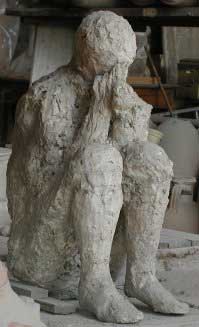 |
|
Image of a person covering their face |
In 62 AD, a powerful earthquake devastated Pompeii, causing many architectural structures to collapse. The ruins seen today in Pompeii are remnants of this earthquake. After the quake, the people of Pompeii set about rebuilding the city, even aspiring to create a more magnificent metropolis.
However, before the new Pompeii could fully recover, on August 24, 79 AD, Mount Vesuvius unexpectedly erupted. At that time, Pompeii had a population of about 25,000. While many managed to escape, over 2,000 people were buried under the ash and lava of the volcano. After the eruption, some survivors returned to the ancient city at the foot of Vesuvius to search for belongings they had left behind; however, they found nothing. With the passage of time, the city of Pompeii faded from memory and became lost.
In 1594, a farmer digging a water channel on the land that once belonged to ancient Pompeii stumbled upon a large broken marble slab and some coins. In 1689, another individual in the outskirts of Naples discovered several inscribed stones while digging a well, including one that mentioned Pompeii. These findings led some to speculate that the city of Pompeii was located in this area.
 |
|
Image of a buried person |
In 1748, local farmers continued to unearth artifacts at the ancient site of Pompeii. This marked the beginning of archaeological efforts to explore the ancient city.
Beneath the volcanic ash near a red palm tree, astonishing frescoes were discovered, along with the first skeletal remains, alongside a few ancient coins. Based on the evidence found on the ground, it is believed that this individual was hastily trying to collect the scattered coins when they tragically met their end.
In 1763, John Winckelmann, a German scholar (1717-1768), was appointed as the chief overseer of antiquities in Rome and its surroundings. During his tenure, he visited Vesuvius and Herculaneum, highly valuing the artifacts uncovered in Pompeii. He also took the initiative to reorganize the lost artifacts and outline the historical significance of Pompeii.
 |
|
Image of buried individuals |
Between 1808 and 1815, a French scholar directed the excavation of the “dead city” of Pompeii. However, it was not until 1860 that systematic excavations began. In 1890, archaeologist Giuseppe Fiorelli officially initiated the excavation efforts. He developed new excavation techniques that allowed for the preservation of the remains of the deceased, animals, household items, and wooden structures, vividly reconstructing their original appearances. Visitors can witness hundreds of poses of victims before their deaths: some with their hands on their heads curled up in despair; others with their faces in their hands, bowing down; or clutching their money bags in panic; or a mother embracing her child as they perish together; or slaves attempting to break free from their chains, only to die in captivity. This indeed paints a harrowing picture of tragedy. In a luxurious residence undergoing renovations, both the owner and the carpenters who sought refuge in the corridor perished. Another villa on the outskirts saw the owner and twenty slaves meet the same fate while hiding in a tunnel during the disaster.
To date, only 3/5 of ancient Pompeii has been excavated. Just like Herculaneum, many victims and artifacts remain buried deep beneath the rubble. Nevertheless, the former grandeur of ancient Pompeii is still displayed quite clearly.
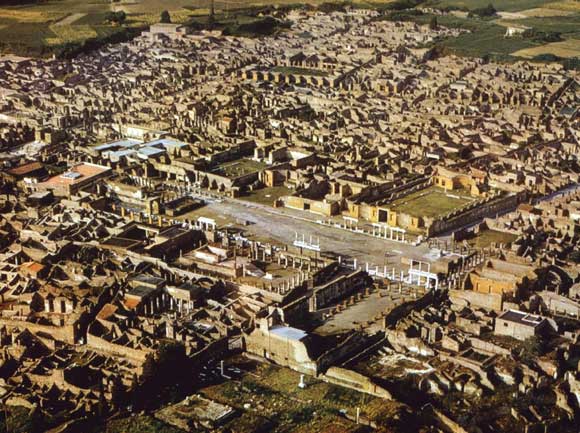
A panoramic view of ancient Pompeii
Ancient Pompeii covers an area of 1.8 square kilometers. The city walls were constructed from stone, stretching 4.8 kilometers long, and featured seven gates along with 14 grand towers. Four major streets, paved with stones, crisscrossed the city, dividing it into nine districts. Each district had interconnected smaller streets; the main roads still show deep iron wheel ruts as if chariots had just passed through.
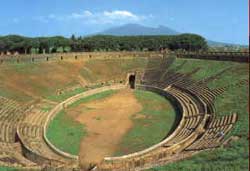 |
|
The Amphitheater |
At the intersections of the main streets, there were stone water fountains nearly 1 meter high and around 2 meters long, providing water to the citizens. The water was channeled from a high mountain spring outside the city through a stone aqueduct. Subsequently, these water towers distributed water to public troughs at the junctions. The fountains and fish ponds of wealthy nobles and merchants also relied on this water supply system.
The people of Pompeii also built two theaters. The largest theater, located in the southeast part of the city, was completed in 70 BC and could hold 20,000 spectators. This venue also served as an arena for gladiatorial contests between men and wild beasts.
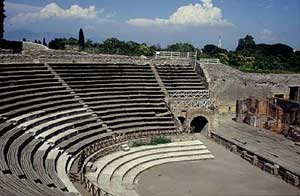 |
|
The Theater |
To the east of the grand theater was a sports arena, measuring approximately 130 meters on each side. This splendid arena had a swimming pool in the center. It is estimated that the arena could accommodate over 10,000 people and regularly hosted economic, political, and religious activities for the entire city of Pompeii.
In the southwest part of the city, there is a rectangular square surrounded by residences, a courthouse, temples, and a marketplace.
There were at least three public baths, including hot and cold baths, steam rooms, and dressing rooms. The walls of these baths were adorned with murals and stone sculptures.
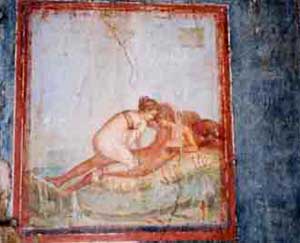 |
|
Scenes of debauchery depicted on tavern walls |
The archaeological site of ancient Pompeii fully reflects the moral decay of ancient Roman society. During that era, a segment of the population indulged in hedonism, living lives of debauchery and extravagant excess. It is no wonder that Pompeii was home to numerous brothels and taverns. The walls of these brothels were filled with depictions of lascivious scenes. Taverns had ovens and counters right at the entrance, allowing patrons to drink while standing outside. Some tavern counters still bear the scribbled inscriptions of drunken patrons, some of which remain legible to this day.
Due to its preservation of valuable artifacts and a complete representation of social life in ancient Rome, Pompeii has become an unparalleled natural history museum in the world.


















































